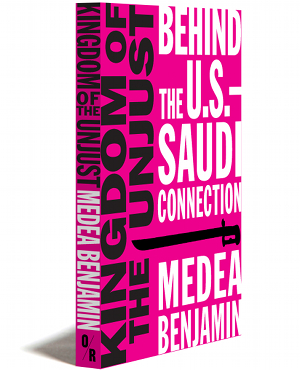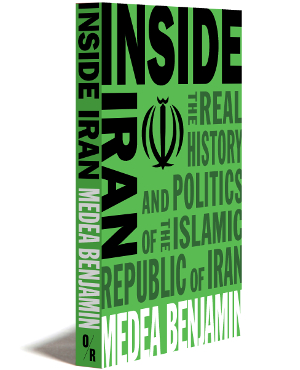
Kingdom of the Unjust
BEHIND THE U.S.–SAUDI CONNECTION
“The voice of that woman is worth paying attention to.” —President Barack Obama
Tweet
Buy This Book
About the Book
The co-founder of CODEPINK has become famous for fearlessly tackling head-on subjects most of us studiously avoid. Sometimes, she does so in person—as during President Obama’s speech at the National Defense University, or during a reception for drone manufacturers and members of Congress, or in Cairo, where she was assaulted by police. Here, she’s researching the sinister nature of the relationship between the U.S. and Saudi Arabia.
In seven succinct chapters followed by a meditation on prospects for change, Benjamin—cited by the L.A. Times as “one of the high-profile members of the peace movement”—shines a light on one of the most perplexing elements of American foreign policy. What is the origin of this strange alliance between two countries that seemingly have very little in common? Why does it persist, and what are its consequences? Why, over a period of decades and across various presidential administrations, has the United States consistently supported a regime shown time and again to be one of the most powerful forces working against American interests? Saudi Arabia is perhaps the single most important source of funds for terrorists worldwide, promoting an extreme interpretation of Islam along with anti-Western sentiment, while brutally repressing non-violent dissidents at home.
With extremism spreading across the globe, a reduced U.S. need for Saudi oil, and a thawing of U.S. relations with Iran, the time is right for a re-evaluation of our close ties with the Saudi regime.
Publication September 8, 2016 • 246 pages
Paperback ISBN 978-1-682190-46-3 • E-book 978-1-682190-47-0
About the Author

|
Medea Benjamin is one of America’s best-known 21st-century activists. Co-founder of CODEPINK and the fair trade advocacy group Global Exchange, she is the author of Drone Warfare (OR Books, 2012) and has played an active role in the Green Party. A frequent contributor to Alternet, she has a Master’s Degree in both public health and economics. In 2012, she was awarded the U.S. Peace Memorial Foundation’s Peace Prize; she is also recipient of the 2014 Gandhi Peace Award and the 2010 Martin Luther King, Jr. Peace Prize from the Fellowship of Reconciliation. She is mother of two children and currently lives in Washington, D.C. |
Read an Excerpt
Table of Contents
Introduction
1. The Founding of the Saudi State
2. Beheadings and Torture in the Saudi “Justice System”
3. A Religious State Without Freedom of Religion
4. The Struggle of Saudi Women for Equal Rights
5. The Tragic Condition of Migrant Workers
6. Spreading Wahhabism, Supporting Extremism
7. The History of Saudi Relations with the United States and the West
8. How the Kingdom Relates to Its Neighbors
9. The Way Forward
Acknowledgments
Glossary
Further Resources
Endnotes
Index
from the introduction:
. . . . I have seen, firsthand, the deadly effects of U.S. foreign policies. The 2003 U.S. invasion of Iraq destroyed the lives of millions, including many of my dear friends, and unleashed the sectarian hatred that later gave birth to the Islamic State. I recall a conversation with my Iraqi colleague Yanar Mohammad, daughter of a Shiite father and Sunni mother, and founder of the Organization of Women’s Freedom in Iraq. When I asked her what was the most notable legacy of the U.S. invasion of her country, she gave the chilling response: “We, Sunnis and Shia, learned to hate each other.”
In another part of the Middle East, U.S. military support for Israel has wreaked havoc on the lives of Palestinians and aroused the ire of people throughout the region. Continuous U.S. military interventions—from drone warfare in Yemen to overthrowing Muammar Gaddafi in Libya to funneling an endless stream of weapons into the region—have unleashed new levels of violence.
But the United States is not the only nation whose massive footprint has been trampling on the lives of people in the Middle East. The other nation is Saudi Arabia, an oppressive monarchy that denies human rights to its own people and exports extremism around the world. It also happens to be the closest U.S. ally in the Arab world.
During the 1980s and 1990s, I met intolerant and violent young men in Pakistan and Afghanistan who were trained to hate Westerners in Saudi schools. In 2001, I saw my own nation convulsed by an attack on September 11 that was perpetrated mostly by Saudis. It’s not hard to connect the dots between the spread of the Saudi intolerant ideology of Wahhabism, the creation of Al Qaeda and the Islamic State, and the attacks in New York, Paris, Brussels, and San Bernadino.
You can also connect the dots between Saudi Arabia and the failure of some of the historic democratic uprisings associated with the Arab Spring, since the Saudi monarchy did not want calls for democracy to threaten its own grip on power. I was in Bahrain after Saudi tanks crushed the inspiring grassroots encampment in Pearl Square, where tens of thousands had gathered day after day to demand democracy. I will never forget the excitement of being in Tahrir Square during the Egyptian revolution, then watching, aghast, as a military coup backed by the Saudis put some forty thousand activists behind bars. In Yemen, the Saudis took a direct military role in that nation’s internal conflict with a ruthless bombing campaign.
When I travel overseas, people often ask me why Saudi Arabia—a country that is so repressive internally and overseas—is such a close ally of the United States. Iranian friends want to know why the U.S. government is so outspoken about human rights violations in Iran but silent about worse abuses in the Saudi Kingdom. Yemenis ask why my government supplies weapons to the very nation—Saudi Arabia—that bombed their schools and hospitals. Saudi women ask why the United States, which professes great democratic values, props up a regime that treats women as second-class citizens.
The easy answer is oil, weapons sales, and other business interests. Oil has formed the basis for Saudi–U.S. ties; the kingdom has become the largest purchaser of American weapons in the world, and hundreds of billions of Saudi petrodollars help shore up the U.S. economy. But there’s another reason, perhaps more critical than any of the others: the American people have not demanded an end to this dysfunctional, toxic relationship. Why? In part, because they know so little about it.
Even Americans who consider themselves part of a peace movement know virtually nothing about the kingdom. The Saudi press is muzzled, foreign journalists are strictly monitored, and only tourists visiting for religious purposes are allowed in. Add to that a Saudi lobby that lines the pockets of U.S. think tanks such as the Middle East Institute, Ivy League universities such as Harvard and Yale, and influential institutions from the Clinton Foundation to the Carter Center. This checkbook diplomacy helps put a happy face on the abusive monarchy and silence its critics.
So we have a lot to uncover. This book is meant to be a primer, giving readers a basic understanding of how the kingdom holds on to power internally and how it tries to influence the outside world. It looks at the founding of the Saudi state; the treatment of dissidents, religious minorities, women, and migrant workers; the spread of Wahhabism; the kingdom’s relationship with the West and its role in the region; and what the future might hold.
As we delve into the inner workings of this dystopian regime, don’t mistake criticism of Saudi Arabia for Islamophobia. This book is not a critique of Islam but a critique of three intertwining factors that have shaped the Saudi nation: the extremist interpretation of Sunni Islam known as Wahhabism, the appropriation of the Saudi state by one family, and the Western support for this dynasty.
In the Media
- “Biden’s Embrace of Saudi Arabia Despite Horrid Rights Record” — KINGDOM OF THE UNJUST author Medea Benjamin interviewed on Democracy Now! (8/25/2022)
- “You rarely hear the voices of Saudis because the royal family makes sure of that.”- MEDEA BENJAMIN on the disappearance of Saudi journalist Jamal Khashoggi at Sputnik (10/11/2018)
- MEDEA BENJAMIN, author of KINGDOM OF THE UNJUST on the murder of Saudi journalist Jamal Khashoggi on Democracy Now (10/10/2018)
- “Why Are Democratic Senators Enabling One Of Trump’s Worst Decisions?” MEDEA BENJAMIN in Huffington Post (12/13/2017)
- “10 Reasons the US Should Stick With the Iran Nuclear Deal.” MEDEA BENJAMIN in Alternet (10/16/2017)
- “Time to Hit the Reset Button on US-Korean Policy.” MEDEA BENJAMIN is interviewed by Common Dreams (8/1/2017)
- “Don’t stop long enough to get depressed.” MEDEA BENJAMIN is interviewed in Little Village (7/25/2017)
- “Our War Machine is Hungry.” MEDEA BENJAMIN interviewed on KPFA (7/11/2017)
- “The height of hypocrisy” — MEDEA BENJAMIN on Democracy Now discussing Trump in Saudi Arabia (5/22/2017)
- MEDEA BENJMAIN appears on FAIR’s Counterspin (5/22/2017)





